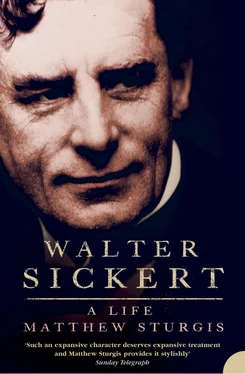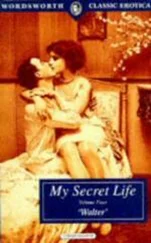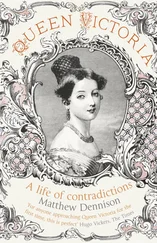Despite his small successes with Rignold and at Sadler’s Wells, Sickert’s acting career still stubbornly refused to ignite. He continued to get scraps of work as a super at the Lyceum, and he seems to have appeared at the Globe; 111 but there were no substantial roles. It is difficult to know why this should have been. From the very limited evidence available it would seem that he had real, if not an exceptional, ability. He had excellent connections, and no shortage of self-belief. As he declared cheerfully to Maggie Cobden, he was blessed with ‘more advantages than most young men on the stage – namely great physical and intellectual [gifts] & a social position’; and indeed Maggie was mystified as to why the London theatre managers were not courting him. He was looking, she considered, particularly ‘beautiful’ in his new dandified persona: for evening wear he had adopted a splendid opera hat ‘of Irving like proportions’, which he wore inclined slightly over one eye to ‘fascinating’ effect. But if it fascinated Maggie Cobden and her friends, it still failed to attract the notice of London theatrical impressarios. 112
His most arduous theatrical engagement during the first half of 1881 was a morning spent with Ellen Terry, ‘flying about Regent Street … having Desdemona night-gowns draped upon him’ as the actress tried to decide on her costume for the forthcoming Lyceum production of Othello . 113 Indeed the Cobden girls were more actively involved in dramatic pursuits than he was: they were busy rehearsing a rather overdressed amateur production of Romeo and Juliet . 114
Walter tried not to be too downhearted by his periods of enforced idleness. He perhaps drew some comfort from the sad predicaments of his brothers, now both embarked on careers of their own. Robert, having passed his school years ‘in a sort of dream’, had been put into the uncongenial surroundings of a London office. Though conscientious, he was quite unable to interest himself in the duties of a ‘merchant’s clerk’. But he lacked the energy to test his own gifts, such as they were, for comic writing and drawing. Bernhard was faring even worse as an assistant master at a private school, a job for which his sister described him as ‘manifestly unfit’. The boys were ‘all over him’. 115 He, like Walter, wanted to be a painter, but his father would not hear of it. And when his teaching career came to a swift and abrupt end, he was found a berth as secretary to the financial editor of The Times – a position made neither easy nor enjoyable by his total inaptitude for figures. 116
For Walter, at least, days of ‘resting’ could be pleasurably spent. His free time, though much taken up with the happy distractions of York Place, was not entirely given over to flirtation and courtship. Leisure also allowed him to pursue other interests. He saw something of Godwin. They went together to William Poel’s production of Hamlet at St George’s Hall. Godwin, according to Sickert’s account, ‘had to leave early and asked me to write a paragraph or two on the production for his paper, the British Architect ’. Although it was Sickert’s journalistic debut, he had no hesitation in boldly urging that it would be ‘a great loss to the professional stage if Miss Helen Maud [the amateur actress in the part of Ophelia] did not become at once a member of it’. 117 It was a good call. Miss Maud (or Maud Holt as she was known off the stage) married the successful actor-manager Herbert Beerbohm Tree the following year, and enjoyed a successful stage-career at his side. Nevertheless, the notice, for all his prescience, did not lead at once to other writing commissions. *
Walter continued to study under his father and to visit Scholderer’s studio, working, as Janie Cobden reported approvingly, ‘pretty hard at his drawing’. 118 Staying with the Scholderers at Putney that June was Henri Fantin-Latour, whose freely worked flower paintings were beginning to get a market in England thanks to the efforts of Mrs Edwin Edwards. 119 He was another link in the great ‘French tradition’ that Sickert was eagerly discovering. Sickert also made a special expedition with Godwin to see The Sower , a painting by the recently deceased Jean-François Millet that was being exhibited at Number 8 Pall Mall. 120 It was his introduction to the work of the so-called Barbizon School. He was impressed by Millet’s carefully constructed picture: a scene of everyday life built up from deep knowledge and accumulated observations. But it did not carry him away as Whistler’s work had done.
Whistler was back in London. After his year-long exile he had announced his return with an exhibition of Venice etchings at the Fine Art Society, closely followed by a show of Venice pastels at the same venue. Sickert feasted upon Whistler’s pictures and became increasingly infected with their vision. On the long summer evenings he would sit in Regent’s Park with Ellen and her sisters, noting the ‘very Whistler like’ effects of the gathering dusk. And then he would try to sketch them. 121
For the last ten or so weeks of the summer, Nellie and Maggie Cobden took a house on the far north coast of Scotland. 122 Sickert, it was agreed, would join them there. He travelled up to Sutherland at the end of July, and was at once charmed by the setting. 123 Rispond House is a fine, almost grand, white-fronted building, set in a perfect little natural harbour near the mouth of Loch Eriboll, a mile or so from the village of Durness. It is a beautiful spot in fine weather, with its little stone jetty, its walled kitchen garden, the hills folding round it, and the clear blue skies stretching northwards towards the Arctic.
The Cobdens were sharing the house with their bluestocking friend Dr Louisa Atkins, who was accompanied by two of her students. Although they dined together, the two parties maintained some lines of informal separation, having the use of the main drawing room on alternate days. The usual tenant of the house, Mr Swanson, an irritatingly garrulous man with a slight facial deformity, had moved into a little house out the back, together with his wife.
Sickert arrived full of his own plans. Maggie described him as being ‘very argumentative & grandfatherly’. His first act was to announce piously that he would be going to bed ‘every night at eight in order to get up at 4 & paint’. 124 Perhaps happily for the general harmony of the party he seems to have abandoned this extreme regime, but he did devote much of his time to work. 125 Ignoring the rather frequent winds and rains (‘the weather is not all we could desire’) – and Mr Swanson’s unhelpful suggestions as to the most picturesque vistas – Sickert would spend whole days ‘working at some beloved subject’ out in the open air, sometimes sustained by nothing more than a piece of oatcake. 126 There were, however, occasional let-ups in the programme, some of them enforced. After painting out of doors for the whole of one dismal afternoon he developed ‘a touch of lumbago’ and had to rest. 127
Besides plunging into his work, Walter also plunged into the sea. It was not a great success. Despite being wrapped up in an elaborate costume of his own devising – ‘bathing drawers’ and a white shirt worn over ankle-length merino combinations – he nearly froze. 128 Maggie, who had given up bathing after a very brief experiment, was delighted to report that when he appeared at lunch after one swimming expedition ‘he was blue & red in the face – his jaws chattered & his hands were dead white & shook as though he had the palsy’. Although he persisted for a while, even his ardour seems to have been dimmed. Scottish bathing, he began to suspect, did ‘not agree with him’. 129 Under the circumstances, he must have been rather impressed by Nellie’s ability to swim each day without ill effect. 130
Читать дальше












